ARCADIA: Idyllic Birthplace of the Greek Nation
Feature by Dalia Miller
ARCADIA: Idyllic Birthplace of the Greek Nation
The first time I heard about Arcadia was in a high school literature class. My teacher, a modern day muse, held me captive as she read with emotion, evoking a fictional wilderness, a lost world of bucolic bliss. Arcadia was a place where noble savages lived uncorrupted by civilized society, herding their flocks amid lush fields.
Fast forward
to the "real" Arcadia. It too is a remote pastoral region, a
slice of paradise tucked into the rugged central mountains of the Peloponnese.
Here also lived Theodore Kolokotrónis, a wild and charismatic leader
whose daring military exploits catapulted the Greeks to Independence after
400 years of oppressive Turkish rule. To Greeks he is a much beloved hero,
as central to their modern history as George Washington is to America's.
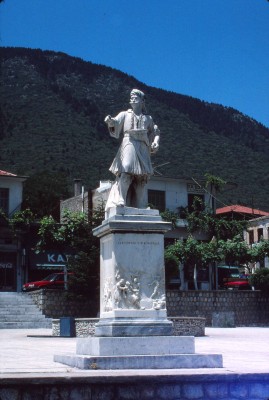
Kolokotronis: Father of the Greek nation
History draws me inexorably to the heights of both Arcadias. On a balmy
June morning my husband and I and our like-minded niece gather under the
bronze statue of Kolokotrónis in Trípolis's central square
to begin our search for the spirit that propelled Greece to its national
destiny. Just exactly how, we wonder, did a region so idealized by romantic
painters and poets fan the flames of liberty? Will we find remnants of
that revolutionary struggle during our four-day visit?
Arcadia's rugged beauty proves instant tonic to our urban weariness. I have read about a string of six medieval villages that swell during summer months with Arcadian-Americans returning for saint day celebrations. Their names alone evoke curiosity: Vítina, Langádia, Stemnítsa, Dhimitsána, Karítaina, and Andrítsena. But I am not prepared for the seductive charm of these towns, where life is lived almost in a time warp and simple pleasures take on new meaning.
To the north,
Vítina clings to the slopes of Mount Mainaláon at a bracing
elevation of 1,000 meters. Here, thick stands of fir and pine provide
raw material for centuries-old traditions of woodcarving. In these woods,
I am certain, Pan frolicked with his nymphs and dryads, playing pipes
similar to the hand-made flutes for sale in some of Vítina's small
shops. Enticed by a window full of carved candlesticks and furniture,
we begin to explore. A pint-sized bakery on a cobbled lane has probably
been there for centuries. The proprietress, a wizened woman in black who
undoubtedly had been turning out country loaves for most of her 70-plus
years, offers us a sample. She retrieves a huge ring sprinkled with sesame
seeds, releasing a wonderful aroma from the wood-burning oven. We are
in culinary heaven. It is bread like no other, with a crunch and flavor
not to be forgotten.
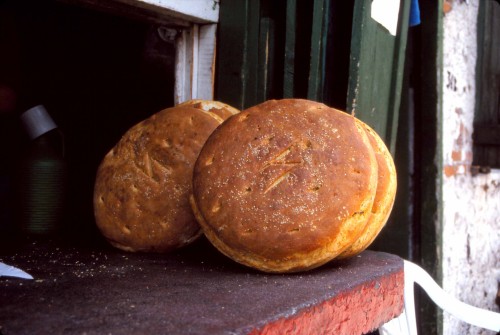
Fragrant rounds of country bread from Vytina's rustic bakery
"During the revolution our town was an educational center,"
she offers when she hears our questions," with a secret school that
was hidden from the Turkish authorities. Of course, Kolokotrónis
is still very much a levéntis (brave role model) for us. Many of
our boys are named Theódoros."
Stopping
in a small pandopouléion (general store), we are immersed in a
sea of olives, fresh oregano, tiny eggplants, giant lima beans, jars of
honey and every necessity of life, all meticulously organized and displayed
by a young wife who assuredly is the power behind her snoring husband.
"Where can we sample some of Vítina's local specialties?"
we ask. She recommends an unnamed restaurant across the street where the
owner is painting window shutters in bright blue.
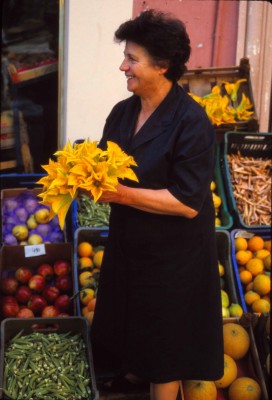
Local market in Kalavryta boasts zucchini
blossoms that make stuffed appetizers
"Eláte" (come in), the he exclaims with a broad smile.
"We have home-made noodles with sauce and tourlóu (slowly
braised vegetables)." It is the perfect lunch in a town with such
exemplary produce. Two platefuls later, our host expresses his admiration
for our historical quest.
"You must make a detour to the Monastery of Aghía Lávra," he advises. "The events that took place there were the deciding factor in pushing Kolokotrónis on. It's only a little further north of here; you can stay in Kalávryta."
Winding through the higher elevations of neighboring Acháia Province, we spot the monastery illuminated in the soft glow of the late afternoon sun. No site in Greece is more symbolic of revolution, for it was here that Bishop Germanós first raised the banner of liberty, declaring: "Freedom or Death." We enter the courtyard of the monastery trailing behind a tour of Greek school children. Upstairs in the small museum, the sacred banner hangs on a wall, complete with a Turkish bullet hole. One of the monks elaborates for us:
"The raising of the flag marked the beginning of the rebellion. From that moment on Kolokotrónis turned the entire Peloponnese into a theater of war."
A few kilometers away, Kalávryta is both thriving winter ski resort and summer refuge cradled at the foot of Mount Helmós, one of the highest in the Peloponnese. Yet despite its alpine loveliness, a sense of tragedy hangs in the air. During World War II, German units swept through the town, slaughtering the entire male population in an act of reprisal. Today, two monuments commemorate the dead, one crowning a hill opposite Aghía Lávra, the other across the town. Still-grieving relatives visit each site frequently.
In Kalávryta, handsome shops and busy restaurants line a broad street that fronts the historic railroad station and the schoolhouse where townswomen were imprisoned by the Germans. After feasting alfresco on stuffed zucchini blossoms and local sausages, we retire to the pleasantly comfortable Philoxenía Hotel. I drift off to sleep instantly, imagining how much better it would be if this prosperous town could leave the shadows of its past behind.
The next
day, my husband maneuvers our car on tortuous roads like a local mountain
goat as we cross endless hills and thick forests. By early afternoon we
find ourselves in Langádia, a multi-storied stone village perched
precipitously on the edge of a steep canyon in the heart of Arcadia. During
the 17th and 18th centuries, Langádia was known for its stone masons
who built fine houses as far away as Athens. Today, crochet and woodcarving
are the local handicrafts.
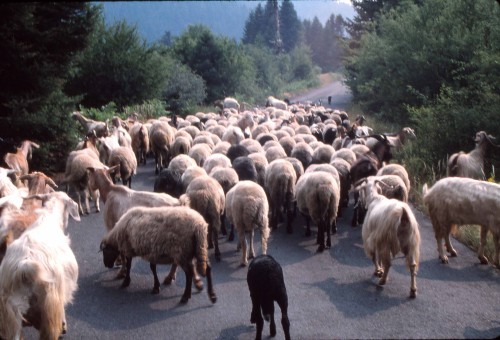
Near Stemnitsa, a herd of sheep and goats meanders in bucolic countryside.
The studio of Athanásios Grigorópoulos, a famous woodcarver,
overlooks the ravine. I can hear him chipping away as we approach. Welcoming
us with open arms, he is an artisan who enjoys the limelight, bringing
out scrapbooks crammed with 35 years of clips on his work and letters
from faraway admirers. Hundreds of spoons, forks, bowls and other paraphernalia
decorate the walls and we quickly select serving spoons on which he carves
his initials.
"Very few of us artisans are left today," he comments in Greek mixed with a little English. "Two hundred plus years ago, woodcarving was a great industry in Arcadia. Our villages were difficult to reach. Not many Turks made it up here. We Arcadians were a resourceful and independent people, strong and upright like our pine trees. We loved our freedom. It is no coincidence that the revolution took root here."
We decide to push on to Stemnítsa where a folk museum is the major attraction. Snaking through dense woods near Limpovítsi, a small sign suddenly catches my eye: "Six kilometers to the home of Kolokotrónis." Can it be? Did we stumble upon something not mentioned in any guidebook? A semi-paved road soon deteriorates into track. Stones fly as we brave hairpin turns, and we regret this little diversion, fearful of a flat tire. The forest turns noticeably darker, with tree trunks now only inches apart. Sunlight can barely penetrate the canopy and ferns blanket the damp ground like a living shag carpet. This is fairy tale country, I conclude, a supernatural place, a breeding ground for heroes.
Without warning, a clearing appears and beyond it a parking lot and small stone house. A solitary guard stands by a kiosk laden with post cards and pamphlets. "Welcome," he waves excitedly. We are probably his only visitors today. "This is the house where the great father of our country grew up. It is a national shrine. Please enter with respect. No food is allowed."
A stone bust of Kolokotrónis marks the parking lot. Inside the carefully restored house, now a museum, we notice his mighty saber resting on dark silk. Flags adorn the walls, flanked by family portraits and scenes of revolutionary battles. Maps pinpoint important events and skirmishes. I imagine Kolokotrónis mounting his steed, long mustache waxed, saber rising in a battle cry. He was a klepht (literally, thief)--a rebel who fought guerrilla-style, hiding in mountain caves and secret strongholds.
On route to Stemnítsa, we encounter a cloaked villager surrounded by a huge herd of sheep and goats. The very incarnation of Poussin's Arcadian shepherd, I think, as he leans on a tall curved crook. A minute later, he raises it baton-like, conducting an orchestra of sheep and goat bells in a random musical composition that echoes in the river gorge below. "Yeia sas" (hello to you), he shouts through the din of bells and bleats as we move slowly and carefully past each animal, chased by four barking dogs.
Stemnítsa, the showpiece of Arcadia, is the town where silversmithing reached a rare art form. Now much depleted of its population, it has benefited greatly by native sons who have made fortunes in the jewelry business in Athens or America and who have given back to the town in the form of public works. We stop immediately at the folk museum. A three-story tower house, it highlights the workshops of the town's metalsmiths. Upstairs we marvel at local costumes, ceramics and antique jewelry from the collections of itinerant craftsmen who sold Stemnítsa's wares throughout Europe and the Middle East. The attendant tells us that several jewelry shops in the town have contemporary pieces by local artisans for sale.
At the elegant Trikolónian Hotel, we delight in our expansive room decorated with fine antiques and original art. A former girls' boarding school with 18 unique rooms and suites, this boutique property is a real find in a rustic town. What a spot to spend the rest of your life in, I sigh as I stretch on the bed for a short nap. We order dinner at the hotel and, to our delight, are regaled with samples of Stemnitsiote cooking at its best: stuffed vine leaves in a delectable lemon sauce and walnut cake laced with honey and cinnamon. At the next table, a portly Athenian lady announces to our surprise that she was once a great opera star. I smile at her disclosure. As we dress for breakfast in the morning, we are rewarded with two arias belted with gusto out of her open windows, undoubtedly reverberating as far as the town square.
Twenty minutes away, Dhimitsána straddles two hillsides atop the Lóusios River. Declared a national historic site, it beckons with cobbled streets, distinctive stone houses, important churches and a large museum and library. We enter an old cafeníon (coffee house) on the main road, finding the last empty table in this male-only establishment. Over tiny cups of Greek coffee, we stare at a wall hung with faded photos of Dhimitsaniotes in their official Greek costume--the foustanélla (white pleated skirt). It's easy to engage the patrons in immediate conversation, for they are as proud and as Greek as they come. Dhimnitsána, we learn, was the powder mill of the Revolution. Here, too, Bishop Germanós was born and Kolokotrónis and his clan hid out in an undisclosed lair.
"Our
town," one gray-haired patron tells us, "was also the birthplace
of Patriarch Grigóris V, who was later hanged in Constantinople
after the Sultan got news of the insurrection."
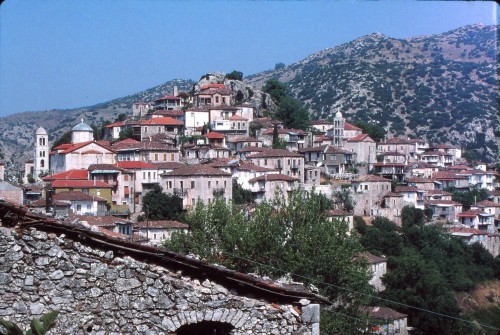
View of Dhimitsana, once the powder keg of the Greek revolution
Climbing up steep streets, we visit Dhimitsána's library museum
which houses an extensive folklore collection and rare manuscripts. At
every turn, charming small hotels beckon, as does a fragrant shop on the
main road selling locally made artisanal soaps, oils, honey and spoon
sweets. By late afternoon, we head to En Dhimitsáni, our xenónas
(guesthouse) on the outer edge of town. Although recently built, it is
fashioned in traditional style of local stone, with spacious and well
appointed rooms commanding sweeping views. At breakfast, omelets made
from freshly-laid eggs collected by the lady of the house are the best
we have ever tasted in Greece.
How can one visit Dhimitsána without seeing its open-air water power museum? We find it tucked into a picturesque side road. Funded in part by the EU and recipient of a Europa Nostra heritage award, it is a shining example of what can be done with good planning and a decent budget. A fully restored pre-industrial milling installation (in actual operation from the 16th to the mid 20th centuries), it is solely powered by the Ai-Yiánnis spring rushing down from the Lóusios gorge. Both tanning and corn milling demonstrations are fascinating to watch, as well as an audio visual presentation in Greek and English.
It is nearly noon and plenty hot when we start for Karítaina. We stop to fill plastic bottles with cold water from a mountain stream. Astride a high hill above the Alfios River, this once prosperous town is best known for a medieval bridge pictured on the defunct 5000-drachma note. Now a depleted community of only 200, Karítaina has two important but decaying churches and a Frankish castle where, in 1826, Kolokotrónis held out against Ibrahim Pasha in the pivotal battle of the War of Independence. We bypass the town for a stroll on the old bridge. Nearing the river, the town appears impregnable from afar and it is easy to see how the Turkish garrison met defeat under the ramparts of its once-formidable castle.
Andrítsena is our final destination. A medley of pale peach and russet, it is a graceful town with faded wooden houses. At the edge of town the old fashioned Theoxenía Hotel offers sweeping mountain vistas and simple if out of date amenities. A small homestyle restaurant is recommended by the reception and we amiably climb into town. After a few wrong turns, we knock on the weather-beaten door of a small house at half past three. "Are you still open for lunch," we ask the startled lady of the house. "Málista" (of course), she responds with characteristic grace.
We drain several Mythos beers as our hostess whirls around her small kitchen, opening and closing cupboards, adjusting the stove, measuring out oil, slicing bread. Greeks are born improvisers and this restaurateur-housewife is no exception. Plates of savory braised chicken, stuffed tomatoes, freshly fried potatoes, and local olives and cheese soon crowd our table.
"Is
there a folk museum in town?" we inquire. "Yes, but it's not
a formal museum, just a collection," she replies. "I happen
to have the key." We follow her single file through a back alley,
dodging donkey droppings and fast-footed cats. She turns the key in an
old iron gate of a once elegant house crammed with dusty memorabilia,
old weapons and costumes. I can make out Kolokotrónis's now familiar
face in a painting in the foyer. On a far wall, a framed copy of "Ode
to Liberty," by Solomós, Greece's national poet, is translated
into English.
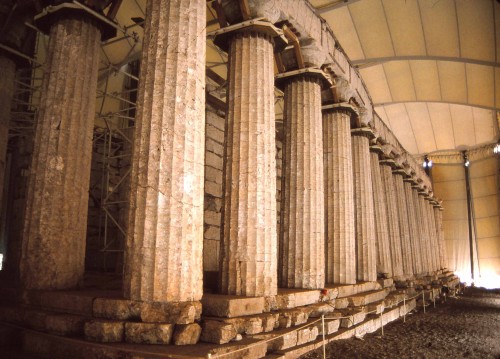
Temple of Apollo Epikurious at Bassae, designed by the same architect as The Parthenon.
By dusk, we arrive at the Temple at Bassae, dedicated to Apollo Epikóurious..
One of the best preserved classical sites in Greece, it was designed by
the same architect as the Parthenon, Iktínos. Approaching the site,
we are surprised to find it covered by a giant marquee--a huge tent that
stands out against the countryside like a giant prehistoric bird. Hewn
of local limestone, the temple had reached a dangerous state of decay
that necessitated a massive restoration effort. The guard at the site
has no idea how long the temple will remain covered. He leads us around
the perimeter where remnants of the disassembled frieze lay on the ground.
I am amazed how little had been pillaged during 2500 years. Even during
the Revolution, it escaped virtually unscathed. Later, I am shocked to
learn that some of the frieze is housed in the British Museum where Greece's
beloved Parthenon marbles are still displayed.
At the last bend before our return to Andrítsena, a baggy-trousered shepherd is guiding a small herd home from pasture. He stops for our cameras, smiling as we snap him in the last stage of sunset. Orange and lavender streak the sky.
"I am a descendant of Kolokotrónis," he volunteers when we ask his name, boasting that he also owns one of the hero's original daggers and knows how to use it. "If Greece were ever to need me, I would defend her to my last breath," he vows.
The herd moves quickly through the bushes. In an instant he is gone, swallowed by the purple Arcadian night.
